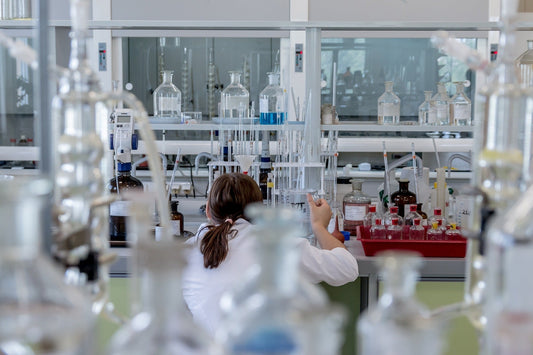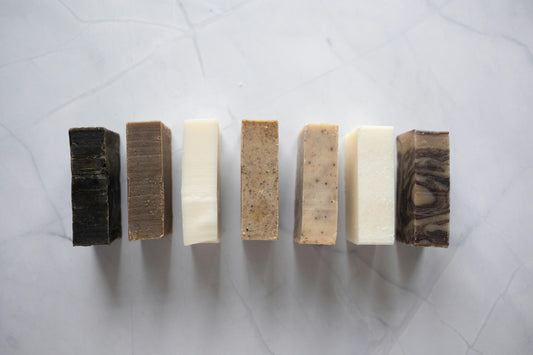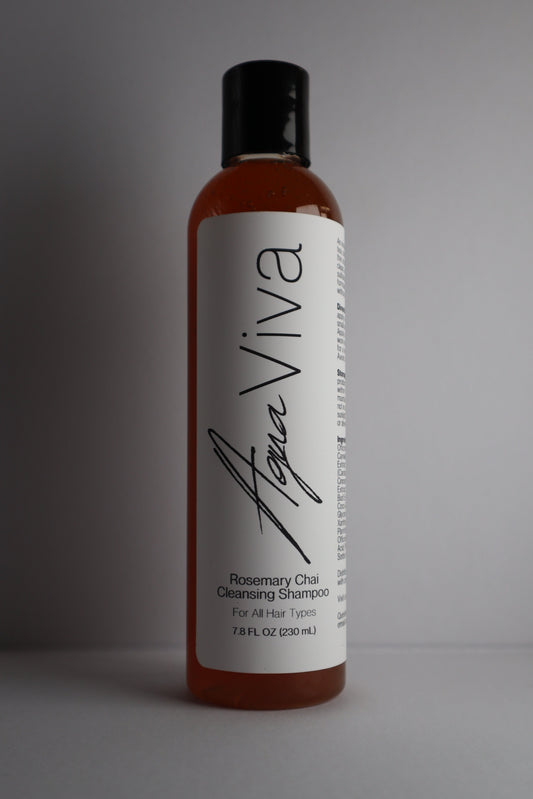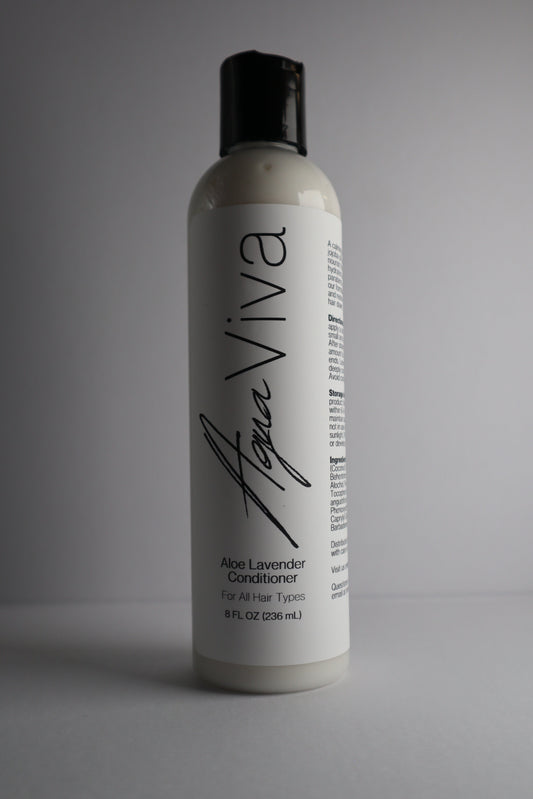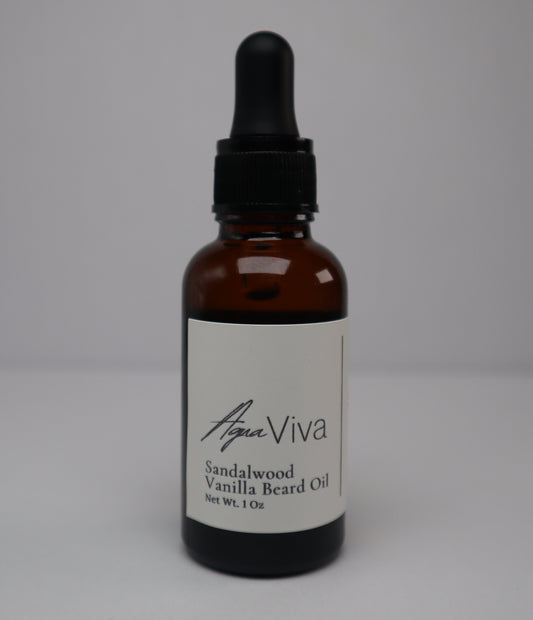
How It's Made - Rosemary Chai Cleansing Shampoo
Compartir
At Agua Viva, we believe that everyone deserves to know exactly what goes into the products they use. We are committed to explaining things in normal, everyday language you can understand and avoiding lofty, misleading, or deceitful marketing language that is so prevalent in the personal care industry.
Our mission is to help consumers fully understand the products they use above all else.
As part of our commitment to this mission, we add QR codes to our packages so you can read about how the product you are using is made and learn more about each ingredient.
How Our Rosemary Chai Shampoo is Made
Step 1: Herbal Infusion
Distilled Water – A base of distilled water acts as the main solvent that carries other ingredients. This is the first and most important ingredient in virtually all shampoos.
Rosemary Leaf – Rosemary is infused into the base of the shampoo. Although more research needs to be done to definitively prove the benefits of rosemary, there are many promising studies and a large amount of anecdotal evidence on how rosemary can improve hair and scalp health. It is not a magic ingredient as some may lead you to believe, but it does appear to have many beneficial properties and it smells really nice!
Chai Tea (Black tea, ginger, cinnamon, black pepper, cardamom, clove, star anise) – In addition to rosemary, chai tea is added to the infusion. The spices in chai tea and the caffeine it contains are thought to have several benefits for hair, including reducing hair fall and improving scalp health. Although scientific research is limited, there are many people that practice and swear by tea rinsing. If you haven't heard of tea rinses for hair, give this a read.
In addition to these potential benefits, it gives our shampoo a really nice smell!
Clove Buds – Clove is thought to have many benefits for the scalp due to its antioxidant and antimicrobial properties. A large part of hair health has to do with the health of our scalp; clove is thought to work by improving blood circulation to the scalp, thus improving scalp health. We have found through our own experience that it contributes to softer and shinier hair. It also smells amazing!
Step 2: Mild Cleansers (Surfactants)
What is a surfactant?
Put simply and without getting too technical, a surfactant works by loosening up dirt and oil so they can be rinsed away with water. Surfactants also make the shampoo foam and help it spread easily through your hair. They are the main ingredient that cleans your hair.
Cocamidopropyl Betaine - This is a surfactant chosen for its mildness and gentle cleansing abilities. It is used in a wide variety of products ranging from cleansing shampoos to baby products and is known for its gentleness. It works to create a rich, foamy lather.
It is often described as "naturally-derived"; this means it is made from natural ingredients that are then processed or modified in some sort of way. While Cocamidroproyl Betaine is much gentler and potentially less processed than other harsh surfactants, insulating that it is 100% natural is misleading. It is derived from coconut oil that is then processed.
It is generally well-tolerated by most but some people may be sensitive.
Coco Glucoside – Coco glucoside is a mild surfactant derived from coconut oil and glucose. It is used in conjunction with the other surfactants listed here for its cleansing and foaming properties.
Similar to Cocamidropyl Betaine, it is considered naturally-derived and therefore it is not 100% natural. It is produced by a chemical reaction between glucose and coconut oil-derived ingredients.
Decyl Glucoside – Another gentle and mild surfactant used for its foaming and viscosity properties. It is derived from cornstarch and coconut oil.
Vitamins & Humectants
What is a humectant?
A humectant is a substance that attracts and retains water, essentially acting as a moisture magnet. Humectants draw water from the air or from deeper layers of the skin (or hair) to hydrate and prevent dryness.
Glycerin – Also known as vegetable glycerin or glycerol, glycerin is a clear, colorless, and odorless liquid derived from vegetable fats; primarily palm, soy, or coconut oil. It's a naturally occurring compound with a sweet taste. Glycerin is generally used as a humectant, meaning it helps retain moisture. humectant that attracts and retains moisture in hair and scalp.
Panthenol (Provitamin B5) – Panthenol is a form of vitamin B5 (pantothenic acid) that's often used in skincare and haircare products. It mainly serves as a moisturizer, emollient, and humectant.
Niacinamide (Vitamin B3) – Niacinamide, a form of vitamin B3, offers several benefits for hair health, including strengthening strands and promoting a healthy scalp. It can also improve hair's appearance by adding shine and body and help regulate oil production on the scalp. There is some conjecture about the benefits of niacinimide in shampoo, but we have found it to be beneficial and our customers have reported positive feedback with the addition of this ingredient.
Thickener & Stabilizers
Xanthan Gum – Xanthan gum is a complex carbohydrate that is often used in food and cosmetic products as a thickener. It is produced by fermenting the bacteria Xanthomonas campestris with sugars like glucose or sucrose. Xanthan gum is used because it is a safe, natural ingredient that gives the shampoo a thicker texture.
Disodium EDTA – Also known as edetate disodium, disodium EDTA is a chelating agent used to bind and remove metal ions from solutions. It is used in personal care products and food and acts as a preservative booster and product stabilizer. In our formulation, it gives our preservatives an extra needed boost and creates a safe, stable product. Disodium EDTA is a synthetic ingredient.
Citric Acid – Used to adjust pH to match the scalp’s natural acidity, supporting skin barrier health. It is found naturally occurring in citrus fruits such as lemons.
Essential Oils & Fragrance
Fragrance – We use a vanilla fragrance oil in our formula to add a nice, sweet undertone and to improve our product's scent.
There is some controversy about the word fragrance (or “parfum”) on an ingredient label. The word "fragrance" represents dozens or even hundreds of undisclosed ingredients used to create a specific fragrance. Fragrance blends are legally protected as trade secrets so companies don’t have to list the full chemical breakdown, which can worry some people, and rightfully so.
Not all fragrances are made equally, though. We source fragrance oils that are skin-safe and use them in low concentrations to avoid potential reactions. Fragrance is an important part of our experience when using a product, but we understand the concerns surrounding this so we exercise caution when including these ingredients.
Rosemary Essential Oil – Rosemary essential oil is an excellent ingredient for hair that can help improve overall scalp health. It also helps boost the nice, herbal rosemary scent.
Preservatives
Why include preservatives?
While preservatives might sound bad, all personal care products must be preserved. Without the use of preservatives, personal care products would begin to grow harmful mold and bacteria within a very short matter of time - we're talking a matter of days or even less. These ingredients are entirely necessary and help keep our product safe.
Phenoxyethanol - A synthetic preservative that prevents bacteria, yeast, and mold from growing in water-based products. It is widely used in formulations that wish to avoid formaldehyde donors or parabens. Although somewhat rare, some individuals may experience skin sensitivity when using products containing Phenoxyethanol.
Caprylyl Glycol - A preservative booster that has the added benefit of being a skin-conditioning agent. This ingredient mainly adds to the effectiveness of phenoxyethanol. It’s derived from caprylic acid which is found in coconut oil.
Sorbic Acid - Another preservative booster that targets molds and yeasts. Sorbic acid is technically a natural occurring ingredient but is now usually lab-made for consistency.
Potential Sensitivities
As mentioned before, one of our core values is transparency. Full transparency means we don't believe in hiding information - we would rather an informed buyer avoid a particular product of ours if it contains ingredients they are sensitive to.
While these ingredients don't generally cause any reaction for the overwhelming majority of people, for the sake of full transparency, we want to point out ingredients that might cause skin sensitivity for some people. We understand that some of our customers with very sensitive skin may find this information relevant and choose to avoid this product because of certain ingredients.
Ingredients to be aware of:
Phenoxyethanol – Rare cases of skin irritation (estimated less than 1%), especially for those with compromised skin barriers or existing sensitivities.
Essential Oils or Fragrance – Naturally fragrant but may trigger reactions in individuals with fragrance sensitivities or allergies.
Niacinamide (Vitamin B3) – Generally well-tolerated, but can cause flushing or mild tingling for sensitive individuals.
Chai Tea - Our chai tea is mostly made up of black tea but also contains ginger, cinnamon, black pepper, cardamom, clove, star anise. These aren't in high enough concentrations to cause sensitivity for most, but we understand some people with extra-sensitive skin may choose to avoid them.
Have questions about a product? Shoot us an email at info@aguavivacare.com!

